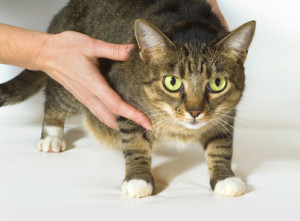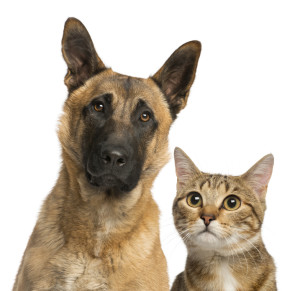You Are What You Eat
Nutrition is the foundation of good health. Good nutrition optimizes the immune system, organ function and longevity. Feed your pet a high quality diet in which the first ingredient is a protein such as chicken, beef, lamb, fish or soy and in which all of the ingredients are recognizable in comparison to a list of unpronounceable chemicals. Beyond these basics, you may look for phrases such as human grade, no by-products and organic to indicate the degree of quality of the pet food.
A recent surge of grain-free diets have arrived on the market. Grain-free formulas are ideal for pets with known food allergies, particularly allergies to grains. Some pets with digestive issues, skin sensitivities, or seasonal allergies may also benefit from a grain-free diet. For most other pets, grain-free formulas are optional. Some pets suffer protein allergies and will require a prescription diet.
An added benefit of a high quality pet food is evident in the yard or litter box. A highly digestible diet (one without fillers) produces less fecal matter. Although a high quality diet may cost more initially, most pets eat less since every bite is full of good, digestible nutrition. Interestingly, most high quality pet foods are not advertised on television. Choose a pet food which is not only affordable but is also convenient to obtain.
What’s better, canned or dry pet food? For dogs, I generally recommend dry formulas. It may be helpful to moisten the food with warm water to facilitate digestion, especially in large breed dogs. Cats, on the other hand, maintain their weight and protect their kidneys better with canned food.
Meal feeding or free choice (grazing)? Offering your pet food at regular intervals will assist you in predicting when he or she needs to eliminate. This is particularly helpful in housebreaking a puppy, since most pets will go to the bathroom about 15 minutes after each meal. Many pets who have food available at all times tend to overeat. Obesity is a becoming a pet epidemic in the United States and leads to a number of preventable diseases such as diabetes, heart disease and arthritis.
It is best to change your pet’s brand of food or formula gradually. Pets’ digestive bacteria need time to acclimate and adjust to a new formula or brand. They generally cannot tolerate different foods for each meal as we can. So, gradually introduce a new food. For example, a large dog who eats 1 cup of dry food per meal will convert to a new diet as follows. Serve ¼ cup of the new food with ¾ cup of the existing diet for each meal for 3 days. Then, give ½ cup of the new food and ½ cup of the “old” food for each meal for 3 days. Then, give ¾ cup of the new food and ¼ cup of the old food for each meal for 3 days. Finally, serve 1 cup of the new food for each meal. This slow transition will help your pet avoid diarrhea and vomiting and ease him or her into the new food.
Pets may continue to eat the same food for an extended period of time. Although we need to eat a varied diet, high quality pet food is perfectly balanced for their needs. Whichever high quality food you may choose, it’s important to also make sure your pet gets adequate exercise and is well hydrated.
Feeding your pet well can be confusing. I hope that these guidelines are helpful as we all strive to give our pets the longest, healthiest lives possible.
For a list of high quality pet foods, click this link: http://vetinheights.com/pet-health/feeding-your-dog-or-cat/
Dr. Frezzo is a member of the doTERRA International Veterinary Advisory Board and the co-author of SpOil Your Pet: A Practical Guide to Using Essential Oils in Dogs and Cats.








Recent Comments